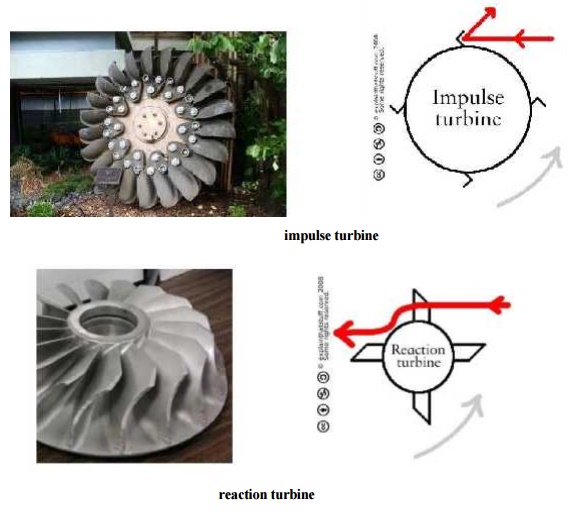Chapter: civil : Applied Hydraulic Engineering: Turbines
Impulse and Reaction Turbines

Impulse turbines
In an impulse turbine, a fast-moving fluid is
fired through a narrow nozzle at the turbine blades to make them spin around.
The blades of an impulse turbine are usually buck et-shaped so they catch the
fluid and direct it off at an angle or sometimes even back the way it came
(because that gives the most efficient transfer of energy from the fluid to the
turbine). In an impulse turbine, the fluid is forced to hit the turbine at high
speed. Imagine trying to make a wheel like this turn around by kicking soccer
balls into its paddles. You'd need the balls to hit hard and bounce back well
to get the wheel spinning-and those constant energy
impulses are the key to how it works.

Reaction turbines
In a reaction turbine, the blades sit in a much
larger volume of fluid and turn around as the fluid flows past them. A reaction
turbine doesn't change the direction of the fluid flow as drastically as an
impulse turbine: it simply spins as the fluid pushes through and past its
blades
If an impulse turbine is a bit like kicking soccer
balls, a reaction turbine is more like swimming-in
reverse. Let me explain! Think of how you do freestyle (front crawl) by hauling
your arms through the water, starting with each hand as far in front as you can
reach and ending with a "follow through" that throws your arm well
behind you.

What you're trying to achieve is to keep your hand
and forearm pushing against the water for as long as possible, so you transfer
as much energy as you can in each stroke. A reaction turbine is using the same
idea in reverse: imagine fast-flowing water moving past you so it makes your
arms and legs move and supplies energy to your body! With a reaction turbine,
you want the water to touch the blades smoothly, for as long as it can, so it
gives up as much energy as possible. The water isn't hitting the blades and
bouncing off, as it does in an impulse turbine: instead, the blades are movin g
more smoothly, "going with the flow".
Related Topics